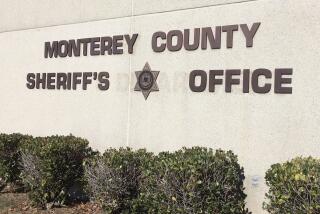In a first for San Diego police, genetic genealogy helps crack 1979 homicide case
- Share via
Barbara Becker’s boys were just 7 and 9 years old on March 21, 1979, the day they returned from school, headed into the living room and found their mother’s bloody body. She had been repeatedly stabbed in the neck and back.
Investigators found blood in several rooms of the La Jolla home. Police at the time said Becker, 37, had tried to escape her attacker. She had fought hard. Some of the blood was his.
It would take four decades to name a suspect. The answer would come through genetic genealogy, a sleuthing method that combines DNA and family trees.
On Thursday, exactly 40 years to the day after Becker’s death, San Diego police announced they had solved her slaying, identifying the suspect as Paul Jean Chartrand.
Chartrand died 24 years ago. Police did not say how old he was or how he died.
Thursday’s announcement marked the first time that San Diego police have publicly named a suspected killer whom they identified through genetic genealogy — a method that gained national attention last year after it was used to identify a suspect in the Golden State Killer case.
It’s also the third time authorities in the region have closed a case by following leads generated through genetic genealogy.
With the method, expert genealogists try to match DNA from a crime scene to relatives — a third cousin will do — who have uploaded their DNA into publicly accessible databases. A hit helps genealogists generate family trees in hopes of putting a name to the mystery DNA.
San Diego police homicide Lt. Matt Dobbs said in a written statement Thursday that the team is “grateful the case has been solved. However, it is tempered by the fact it took 40 years to give Barbara Becker’s family the answers they deserved, and that Chartrand was able to avoid justice for 16 years after Barbara Becker’s murder.”
Dobbs said the Becker and Chartrand families have asked for privacy, and that the Chartrands have also “expressed their condolences.”
He and she were strangers. It seems it was a burglary gone bad.
In 1979, the San Diego Union reported that the Beckers had lived in the La Jolla home off Torrey Pines Road, not far from UC San Diego, for seven years.
Barbara Becker was last seen at 8:30 a.m. on the day she died. She had failed to show up for a 10 a.m. salon appointment.
Her husband, a doctor at the Veterans Administration hospital, had been at work that day.
Becker’s young sons found her body about 1 p.m. Terrified, they ran to a neighbor’s home for help.
Based on the evidence at the scene, Becker “put up a tremendous fight for her life,” Dobbs said.
But the case went cold, and despite forensic advancements, it stayed that way. Chartrand died in 1995, before his DNA made it into criminal databases.
Last October, San Diego police investigators and the district attorney’s office turned to the FBI’s investigative genealogy team for help.
They found a distant relative through a public database and worked it backward to identify Chartrand’s direct family members, who agreed to provide DNA.
Through that, Chartrand was identified as the source of the blood at the crime scene.
Genetic genealogy became criminology’s newest tool nearly a year ago, with the announcement that it had been used to catch the suspected Golden State Killer — so named for a series of at least 13 murders and more than 50 rapes in California from 1974 to 1986.
The method has increasingly become viable for investigators thanks to a sharp rise in consumer DNA testing — such as provided by Ancestry or 23andMe.
Police do not use and do not have access to databases of those and other companies. Instead, law enforcement-based searches are done in public databases — GEDmatch, with 1.2 million DNA profiles, is the biggest.
To be a part of the public database, consumers must intentionally upload their DNA data onto the site.
Since November, police in San Diego County employing the method have publicly identified suspected killers in two cold cases: the 2006 stabbing death of Scott Martinez in La Mesa, and the 2007 beating death of Jodine Serrin in Carlsbad.
Figueroa writes for the San Diego Union-Tribune.
More to Read
Sign up for Essential California
The most important California stories and recommendations in your inbox every morning.
You may occasionally receive promotional content from the Los Angeles Times.











